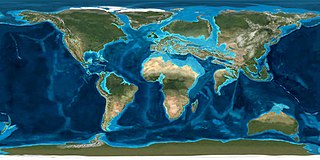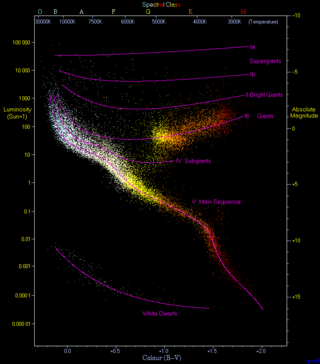Related Research Articles

Seismology is the scientific study of earthquakes and the generation and propagation of elastic waves through the Earth or other planetary bodies. It also includes studies of earthquake environmental effects such as tsunamis as well as diverse seismic sources such as volcanic, tectonic, glacial, fluvial, oceanic microseism, atmospheric, and artificial processes such as explosions and human activities. A related field that uses geology to infer information regarding past earthquakes is paleoseismology. A recording of Earth motion as a function of time, created by a seismograph is called a seismogram. A seismologist is a scientist works in basic or applied seismology.

A blue supergiant (BSG) is a hot, luminous star, often referred to as an OB supergiant. They are usually considered to be those with luminosity class I and spectral class B9 or earlier, although sometimes A-class supergiants are also deemed blue supergiants.

Molluscum contagiosum (MC), sometimes called water warts, is a viral infection of the skin that results in small raised pink lesions with a dimple in the center. They may become itchy or sore, and occur singularly or in groups. Any area of the skin may be affected, with abdomen, legs, arms, neck, genital area, and face being the most common. Onset of the lesions is around seven weeks after infection. They usually go away within a year without scarring.
Fibrillation is the rapid, irregular, and unsynchronized contraction of muscle fibers. An important occurrence is with regard to the heart.

Gamma Virginis, officially named Porrima, is a binary star system in the constellation of Virgo. It consists of two almost identical main sequence stars at a distance of about 38 light-years.

'De Camptown Races' or 'Gwine to Run All Night' is a minstrel song by American Romantic composer Stephen Foster. It was published in February 1850 by F. D. Benteen and was introduced to the American mainstream by Christy's Minstrels, eventually becoming one of the most popular folk/Americana tunes of the nineteenth century. It is Roud Folk Song Index no. 11768.

Delta2 Tauri is a solitary, white-hued star in the zodiac constellation of Taurus. Based upon an annual parallax shift of 20.21 mas as seen from Earth, it is located roughly 161 light years distant from the Sun. It is separated from δ1 Tauri by 0.3° on the sky and is faintly visible to the naked eye with an apparent visual magnitude of +4.80. The star is considered a member of the Hyades cluster.

In the geologic timescale the Ypresian is the oldest age or lowest stratigraphic stage of the Eocene. It spans the time between 56 and47.8 Ma, is preceded by the Thanetian Age and is followed by the Eocene Lutetian Age. The Ypresian is consistent with the Lower Eocene.

The ocean quahog is a species of edible clam, a marine bivalve mollusk in the family Arcticidae. This species is native to the North Atlantic Ocean, and it is harvested commercially as a food source. This species is also known by a number of different common names, including Icelandic cyprine, mahogany clam, mahogany quahog, black quahog, and black clam.

Caspase-6 is an enzyme that in humans is encoded by the CASP6 gene. CASP6 orthologs have been identified in numerous mammals for which complete genome data are available. Unique orthologs are also present in birds, lizards, lissamphibians, and teleosts. Caspase-6 has known functions in apoptosis, early immune response and neurodegeneration in Huntington's and Alzheimer's disease.
HD 153791 is a double star in the southern constellation of Ara. The primary is a sixth magnitude A-type main sequence star. It has a magnitude 12.3 companion at an angular separation of 6.0″ along a position angle of 249°, as of 1999.
HD 23089 is a spectroscopic binary star in the northern constellation of Camelopardalis. Based on stellar parallax measurements made by Hipparcos, the system is about 800 ly away from the Sun.

The Hertzsprung–Russell diagram is a scatter plot of stars showing the relationship between the stars' absolute magnitudes or luminosities and their stellar classifications or effective temperatures. The diagram was created independently in 1911 by Ejnar Hertzsprung and by Henry Norris Russell in 1913, and represented a major step towards an understanding of stellar evolution.
"Devil in the Bottle" is a song written by Bobby David and recorded by American country music artist T. G. Sheppard. It was released in October 1974 as his debut single and the first from his album T. G. Sheppard, and reached number one on the U.S. country singles chart. The single spent a single week at number one and a total of ten weeks on the chart. The single was released on the Melodyland Label, a country music, Motown subsidiary.
HD 196761 is the Henry Draper Catalogue designation for a G-type main-sequence star in the constellation Capricornus. With an apparent magnitude of 6.37 it is near the limit of what can be seen with the naked eye, but according to the Bortle Scale it may be possible to view it at night from rural skies. Based upon parallax measurements by the Hipparcos spacecraft, it is located about 47 light years from the Solar System.

Folliculogenesis-specific basic helix-loop-helix, also known as factor in the germline alpha (FIGalpha) or transcription factor FIGa, is a protein that in humans is encoded by the FIGLA gene. The FIGLA gene is a germ cell-specific transcription factor preferentially expressed in oocytes that can be found on human chromosome 2p13.3.

para-Chloromethamphetamine is a stimulant that is the N-methyl derivative and prodrug of the neurotoxic drug para-chloroamphetamine (4-CA). It has been found to decrease serotonin in rats. Further investigation into the long-term effects of chloroamphetamines discovered that administration of 4-CMA caused a prolonged reduction in the levels of serotonin and the activity of tryptophan hydroxylase in the brain one month after injection of a single dose of the drug.
The South Patagonian Batholith is group of plutons in southwestern Patagonia. The rocks of batholith include granite, leucogranite, tonalite, granodiorite, diorite, gabbro and mafic dykes. The earliest plutons of the batholith formed in the Late Jurassic with the magmas likely being derived from anatexis. This early magmatism produced a bimodal magmatism that formed both leucogranite and gabbro.

NGC 3489 is a lenticular galaxy located in the constellation Leo. It is located at a distance of about 30 million light years from Earth, which, given its apparent dimensions, means that NGC 3489 is about 30,000 light years across. It was discovered by William Herschel on April 8, 1784. NGC 3489 is a member of the Leo Group.
Neo-colonial research or neo-colonial science, frequently described as helicopter research, parachute science or research, parasitic research, or safari study, is when researchers from wealthier countries go to a developing country, collect information, travel back to their country, analyze the data and samples, and publish the results with no or little involvement of local researchers. A 2003 study by the Hungarian Academy of Sciences found that 70% of articles in a random sample of publications about least-developed countries did not include a local research co-author.
References
- ↑ Wessels, Anton (2006-01-01). Muslims and Christians between Confrontation and Dialogue. Brill. doi:10.1163/9789401202329_018. ISBN 978-94-012-0232-9.
- ↑ Desmond, Karen; Zayaruznaya, Anna (August 2018). "Editorial". Early Music. 46 (3): 373–373. doi: 10.1093/em/cay067 . ISSN 0306-1078.